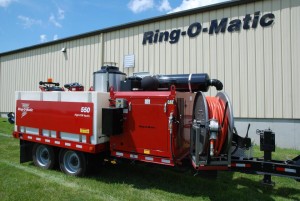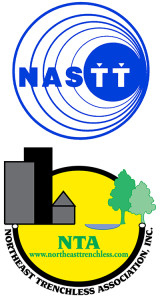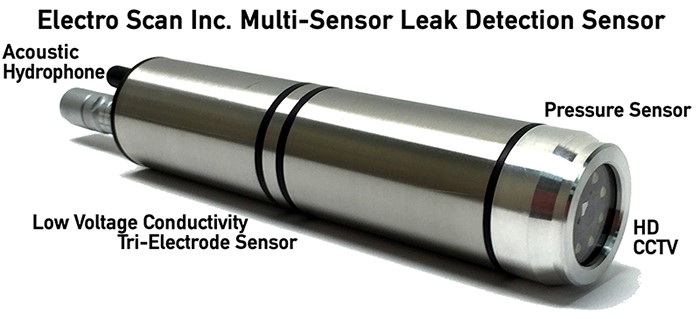Uncategorized
 September 29, 2015 – PELLA, Iowa– The Ring-O-Matic 550 Dual Pump Combination Sewer Line Jetter and Vacuum Excavator gives contractors and municipalities the advantages of a dedicated, combination jetter/vacuum truck in the more versatile footprint of a compact trailer unit. Compared to PTO-driven, truck-mounted models, the Ring-O-Matic 550’s low initial investment cost and lower operational costs have made owning a combination jetter/vacuum machine affordable even for those who do not need jetting and/or vacuum excavation services on a daily basis.
September 29, 2015 – PELLA, Iowa– The Ring-O-Matic 550 Dual Pump Combination Sewer Line Jetter and Vacuum Excavator gives contractors and municipalities the advantages of a dedicated, combination jetter/vacuum truck in the more versatile footprint of a compact trailer unit. Compared to PTO-driven, truck-mounted models, the Ring-O-Matic 550’s low initial investment cost and lower operational costs have made owning a combination jetter/vacuum machine affordable even for those who do not need jetting and/or vacuum excavation services on a daily basis.
The Ring-O-Matic 550 fits into spaces too confined for truck-mounted combo rigs, yet it can clean sewer lines up to 20 inches in diameter. Its versatility makes it a practical alternative for numerous other applications, as well, such as potholing and lateral cleaning.
Powered by an 81 hp CAT turbo diesel, the Ring-O-Matic 550 machine features a 1,000 cfm blower and can deliver 27 gpm at 2,700 psi up to 400 feet with its ¾-inch jetter hose. The trailer’s axles are rated to 16,000 pounds, allowing the 550-gallon spoils tank and 500-gallon freshwater tank to be easily pulled behind a suitably equipped ¾- or 1-ton truck.
Bob Zylstra, Ring-O-Matic’s engineering director, said the unit’s compact size makes it particularly attractive not only to smaller municipalities but also to larger cities looking for a utility combo jetter to complement their truck-mounted units.“Its low profile offers a 2- to 3-foot height advantage over truck-mounted units. It’s less than half their weight and it’s narrower. This makes it easier to use in tight alleyways with overhead obstructions, with less potential for damage to soft asphalt or brittle cement pavements.”
In addition to its versatility, Ring-O-Matic CEO Brian Metcalf believed the trailer-mounted Ring-O-Matic’s price-point has now offered the advantages of jetting to customers who could not previously justify purchasing jet-vac equipment. “Customers will quickly learn that although they acquired their Ring-O-Matic 550 with one purpose in mind, they’ll see many other applications they can use it for.”
Should customers have questions or need assistance of any kind, Metcalf said Ring-O-Matic has ideal logistics for industry-leading responsiveness. “Although we have a global presence in the industry, our modest company size and our ideally located headquarters in Pella, Iowa, enable us to provide close customer support to every region of the U.S.”
The Ring O Matic 550 Dual Jetter Combo will be on display in booth K-160 at the 2015 International Construction & Utility Equipment Exposition in Louisville, Kentucky, September 29 through October 1.
For more information, contact:
Matt Fueston
Ellenbecker Communications
507-945-0105
Ring-O-Matic, Inc. of Pella, Iowa, USA, manufactures a full line of vacuum excavation machines and car wash pit cleaners. Ring-O-Matic’s product line has a strong reputation for reliability and ease-of-use. Ring-O-Matic offers worldwide sales, support, service and parts through a network of authorized dealers. For more information about Ring-O-Matic products, please call 800-544-2518 or visit www.ring-o-matic.com.
Uncategorized
Release Date: 09/24/2015
Contact Information: George Hull, hull.george@epa.gov, (202) 564-0790, (202) 564-4355
WASHINGTON — Today, the U.S. Environmental Protection Agency (EPA) finalized a rule to modernize Clean Water Act reporting for municipalities, industries, and other facilities. The final rule will require regulated entities and state and federal regulators to use existing, available information technology to electronically report data required by the National Pollutant Discharge Elimination System (NPDES) program instead of filing written paper reports.
EPA estimates that, once the rule is fully implemented, the 46 states and the Virgin Islands Territory that are authorized to administer the NPDES program will collectively save approximately $22.6 million each year as a result of switching from paper to electronic reporting. The final rule will make facility-specific information, such as inspection and enforcement history, pollutant monitoring results, and other data required by NPDES permits accessible to the public through EPA’s website.
“Electronic reporting will give the public full transparency into water pollution sources, save millions of dollars, and lead to better water quality in American communities,” said Cynthia Giles, assistant administrator for EPA’s Office of Enforcement and Compliance Assurance. “This rule will significantly reduce the burden and costs of paperwork, freeing up limited resources for states and other regulatory authorities to focus on the most serious water quality problems. After more than two years of working closely with states and a range of stakeholders, today we take a critical step to bring clean water protection into the modern age.”
“ECOS is pleased to see a rule move ahead that modernizes how businesses, states, and the federal government interface and share information in the clean water program,” said Alexandra Dapolito Dunn, Executive Director and General Counsel of the Environmental Council of the States. “Our focus going forward with EPA and the impacted regulated community will be on smooth implementation of this rule, and on developing flexible approaches when needed.”
The Clean Water Act requires that municipal, industrial or commercial facilities that discharge wastewater directly into waters of the United States obtain a permit. The NPDES program requires that permitted facilities monitor and report data on pollutant discharges and take other actions to ensure discharges do not affect human health or the environment. Currently, some facilities subject to these reporting requirements submit data in paper form to states and other regulatory authorities, where the information must be manually entered into data systems. Through the e-reporting rule, these facilities will electronically report data directly to the appropriate regulatory authority.
EPA proposed the e-reporting rule in July of 2013 with a public comment period. Since then, EPA has held over more than 70 technical and individual meetings with states to review the electronic reporting provisions and to identify any issues requiring resolution. In addition, EPA held over 50 webinars and meetings with over 1,200 stakeholders to discuss the rulemaking. EPA will continue collaborating with states as they enhance their electronic reporting capabilities to support the rule’s implementation. Over the next few months, EPA will schedule trainings and outreach webinar sessions for states and regulated entities to provide an overview of the final rule, and the next steps for implementing electronic reporting.
In response to state feedback, the final rule provides authorized NPDES programs with more flexibility for implementation, providing more time for the transition from paper to electronic reporting and more flexibility in how they can grant electronic reporting waivers to facilities. Most facilities subject to effluent monitoring reporting requirements will be required to start submitting data electronically one year following the effective date of the final rule. A second phase will incorporate electronic reporting for other Clean Water Act reports such as performance status reports for municipal urban stormwater programs, controls on industrial discharges to local sewage treatment plants, and sewer overflows. Also in response to comments and suggestions from states, EPA is providing states with more time to electronically collect, manage, and share this data – up to five years instead of two years as initially proposed.
This rulemaking is part of EPA’s Next Generation Compliance strategy, as well as the E-Enterprise for the Environment strategy with states and tribes, to take advantage of new tools and innovative approaches to increase compliance and reduce pollution. The shift toward electronic reporting in the NPDES program and others will help make environmental reporting more accurate, complete, and efficient. It will also help EPA and co-regulators better manage information, and improve effectiveness and transparency.
EPA expects to publish the final rule in the Federal Register in October, 2015. The final rule will be effective 60 days following this publication.
View the final rule at:
http://www2.epa.gov/compliance/final-national-pollutant-discharge-elimination-system-npdes-electronic-reporting-rule
More information on Next Generation Compliance:
http://www2.epa.gov/compliance/next-generation-compliance
Uncategorized
Cleveland, Ohio – The Northeast Trenchless Association Inc. (NTA) and the North American  Society for Trenchless Technology (NASTT) will join together effective January 1, 2016 to form the NASTT Northeast Chapter. This chapter will cover Connecticut, Maine, Massachusetts, New Hampshire, New York, Rhode Island and Vermont. The goals of the consolidated organization will continue to advance trenchless technology and promote its benefits for the public and the natural environment by increasing awareness and knowledge through technical information dissemination, research and development, education and training.
Society for Trenchless Technology (NASTT) will join together effective January 1, 2016 to form the NASTT Northeast Chapter. This chapter will cover Connecticut, Maine, Massachusetts, New Hampshire, New York, Rhode Island and Vermont. The goals of the consolidated organization will continue to advance trenchless technology and promote its benefits for the public and the natural environment by increasing awareness and knowledge through technical information dissemination, research and development, education and training.
Matt Timberlake, NTA past president, commented: “The Northeast sits on top of some of the oldest buried infrastructure in North America. By pulling together the regional strength of the NTA and its members with the national resources of NASTT, the new Northeast Chapter of NASTT will help serve the diverse utilities market in the northeast and continue to help grow trenchless rehabilitation and construction in the region.”
An industry launch event will be held on Thursday, November 12, 2015, from 5:00 p.m. to 9:00 p.m. in Springfield, Massachusetts. Members of the NTA and NASTT, as well as the Northeast Chapter Steering Committee, will outline the goals of the new association including a call for nomination of officers. The event is open to all industry stakeholders including municipal utility owners and operators, consulting engineers, contractors, suppliers and students. There is no charge to attend the event which will include a social hour and dinner. Click here to register for the event.
The Northeast Chapter of the NASTT Steering Committee is composed of of Scott Kelly, ETTI (2004 NTA President); George Ragula, PSG&E (NASTT Past Chair 2011-2012); Matt Timberlake, Ted Berry Company (NTA Past President); Justin DeMello, Woodard and Curran (NASTT Member); and Matt Boeh, UGSI (2015 NTA President).
Uncategorized
New Patent Pending Multi-Sensor Probe Represents First Device to Accurately Find and Measure Water Losses
SACRAMENTO, Calif. — Electro Scan Inc., a global leader in pipe condition assessment announced its new patent pending multi-sensor probe that accurately finds and measures water losses.
The Company’s game changing leak detection technology is featured as part of a 90-day / 16-city international roadshow that began this week.
Water utilities commonly lose 20-30% of their production before delivery to a customer’s meter, with fixing the wrong pipe often costing 10 times more than fixing the right pipe.
 Since legacy equipment, like acoustic sensors, data loggers, electro-magnetic sensors, and visual inspections are not able to reliably find water leaks, next generation technologies have been needed to accurately assess water mains and certify their repair.
Since legacy equipment, like acoustic sensors, data loggers, electro-magnetic sensors, and visual inspections are not able to reliably find water leaks, next generation technologies have been needed to accurately assess water mains and certify their repair.
“We are delighted to unveil our new technology,” said Chuck Hansen, Chairman, Electro Scan Inc. and former Chairman, Hansen Information Technologies, sold to Infor Global in 2007.
Explains Hansen, “By combining the latest technologies into our 4-in-1 Multi-Sensor Probe, offered as an exclusive service, utilities can quantify each leak’s size, location, and estimated GPM [LPS], in minutes.”
Electro Scan’s technology assesses both pressurized and gravity water mains while pipes remain in service.
The Company’s patent pending multi-sensor probe, includes:
1. Low Voltage Conductivity Sensor– Measures individual leaks and total defect flows utilizing a low voltage conductivity tri-electrode array to find leaking cracks, pinholes, defective joints, bad service connections, and other openings to ground.
2. High Definition Camera– Assists operators in navigating through water mains and documents leak locations found by low voltage conductivity sensor using a standard 1920×1080 high definition camera recording at 30 frames per second (fps).
3. Pressure Sensor– Provides location-specific water pressure to assist in calculating defect flow rates.
4. Acoustic Sensor– Records sound vibrations and provides benchmark of legacy results that can be readily compared to low voltage conductivity results.
“The Electro Scan 4-in-1 water probe was designed to find leaks not previously found by legacy methods,” states Mark Grabowski, General Manager, Electro Scan. “If a pipe leaks electricity, it leaks water. Now we can provide a reliable, repeatable, and measurable solution for the water industry, based on our proven technology already being deployed in the wastewater collection industry.”
Pipe materials best suited for low voltage conductivity surveys, include: Asbestos Cement, Cement-Mortar Lined and Coated Steel Pipe, Cured In-Place Pipe, Fiberglass Reinforced Pipe, High-Density Polyethylene Pipe, Prestressed Concrete Cylinder Pipe, Polyethylene Pipe, Polyvinyl Chloride, and Reinforced Concrete Pipe.
Using a neutrally buoyant fiber optic cable, the Company can evaluate up to 2,000ft (610m) of water main from a single point of entry, accessed through fire hydrants, air valves, flow meters, gate valves, and pressure fittings.
“In the past, acoustic sensors may have suggested locations of general anomalies,” said Carissa Boudwin, Director of Marketing, Electro Scan.
Continues Boudwin, “But, false-positive readings, poor data repeatability, reliance on third party data interpretation, ambient noise from road traffic, water table heights, pipe diameter, and the inability to assess PVC, PE, and HDPE pipes, has limited its usefulness to find non-revenue water losses and optimize CAPEX plans.”
Electro Scan’s 16-city roadshow, includes:
Sept 9-10 IKT Praxistage „Neubau, Sanierung und Reparatur“Gelsenkirchen, Germany
Sept 13-15 SAP for Utilities, North American Conference, Huntington Beach, CA
Sept 14 Water JAM, Virginia Beach, VA
Sept 22-23 Water Innovation Summit, Berkeley, CA
Sept 23-25 Iowa League of Cities, Cedar Rapids, IA
Sept 26-30 WEFTEC, McCormick Place, Booth #2804, Chicago, IL
Oct 11-14 AMWA Executive Management Conference, Savannah, GA
Oct 13-16 AWWA Water Infrastructure Conference, Bethesda, MD
Oct 20 UKSTT Road Show, Bristol, UK
Oct 22 Rocky Mountain Water Environment Association, Vail, CO
Oct 26-29 AWWA Calif-Nevada Annual Conference, Las Vegas, NV
Nov 6 American Leak Detection Annual Meeting, Chicago, IL
Nov 11-13 California Water Association, Monterey, CA
Nov 17-19 Trenchless Technology Roadshow, Richmond, BC
Dec 4 Hawaii Water Environment Association, Honolulu, HI
Dec 8-9 North American Water Loss Conference, Atlanta, GA
Electro Scan has been named Best CleanTech Company (The New Economy), Best Innovative Technology (Water Environment Federation), Innovative Product Award (North American Society for Trenchless Technology) and Best Project (UK Society of Trenchless Technology).
While equipment is not available for purchase, the new technology is available as a professional service offered directly by the Company.
About Electro Scan
The privately-held Company designs advanced instrumentation, mobile, and cloud computing applications that automatically locates, measures, and reports defects in water, sewer, and gas pipelines.
Contacts




